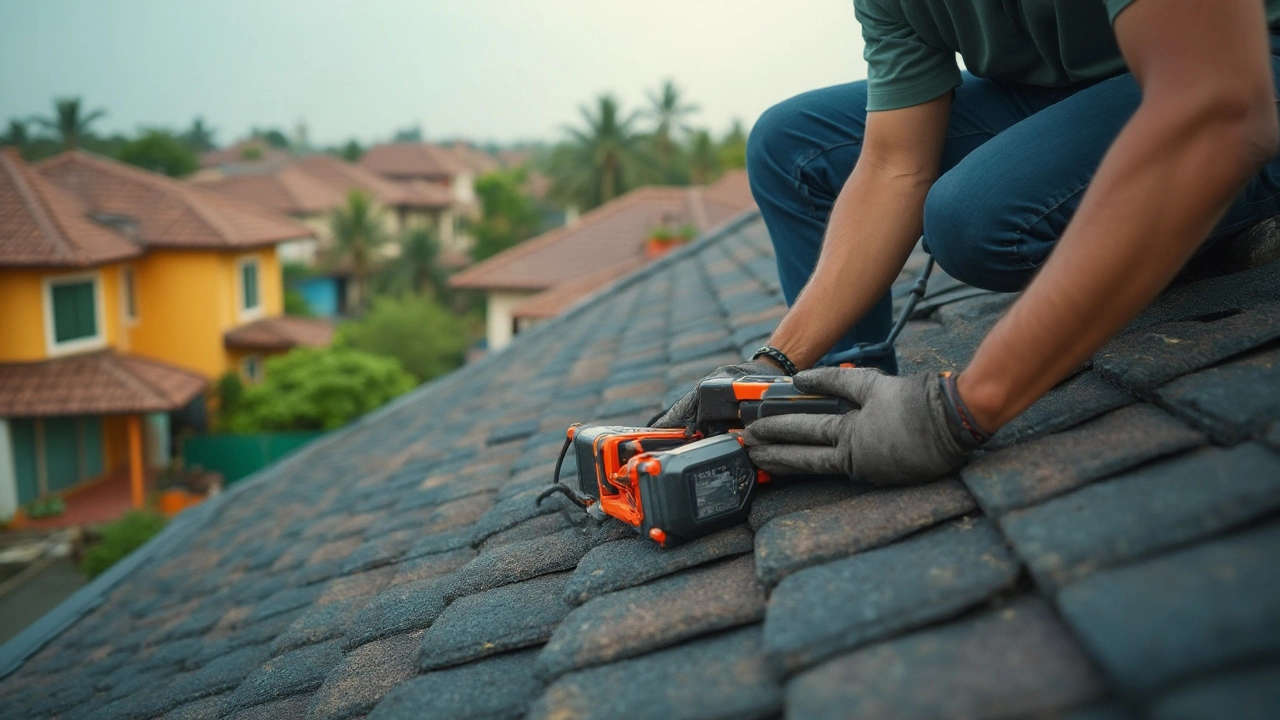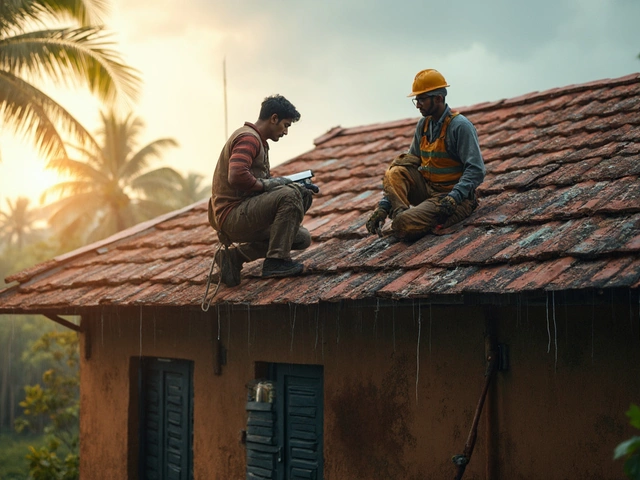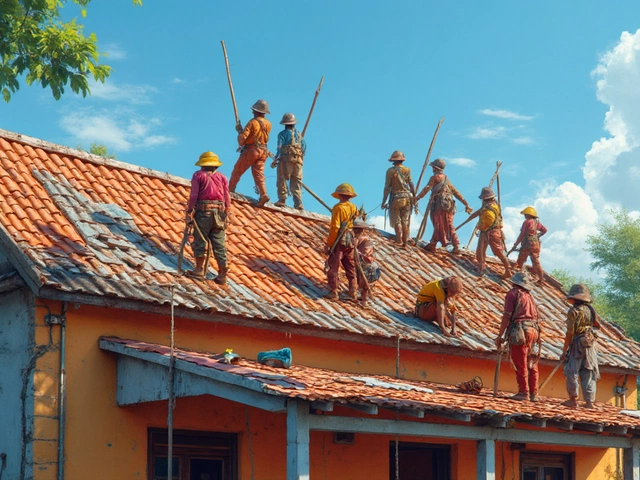Thinking a little leak is no big deal? Most of the time, it’s just the tip of the iceberg. That drip from your ceiling might hide cracked shingles, torn underlayment, or even rotting wood underneath. Trying to patch it yourself could give you a false sense of security—and next time it rains, you’re back to square one, only wetter.
Roofing’s not just about climbing up there with a hammer and some tar. A professional roofer brings years of experience, the right safety gear, and an eye for trouble that you just can’t get from a YouTube video. Ever heard of flashings, soffits, or roof vents? These are all easy to miss but crucial when it comes to keeping water out.
- Why DIY Roof Fixes Go Wrong
- Hidden Roof Problems and How Pros Spot Them
- When to Pick Up the Phone
- How to Find a Roofer You Can Trust
Why DIY Roof Fixes Go Wrong
Grabbing a ladder and patch kit might feel like a money-saver, but here’s the truth—most DIY roof repair jobs end up costing you more in the long run. There’s way more to fixing a busted shingle or a leaky spot than just slapping on some sealant. Homeowners miss stuff that a roofer would catch in a heartbeat, like small cracks under shingles or rusted flashing. You might plug that visible hole, but water can sneak in from somewhere else and rot the wood.
One big issue? Safety. Climbing up on your roof without pro gear or the right shoes is risky—falls are a leading cause of ER visits after home repairs. You can’t always count on your old ladder to hold steady. Roofing services come with not just skills, but also insurance. If you get hurt, no homeowner’s insurance is going to pay your medical bills.
Another common problem: the wrong materials. Hardware stores carry generic supplies, but every roof has its own needs. Using the wrong shingles or nails—or worse, just gluing things in place—can void your warranty. It can even make a small problem spread to other parts of your roof, which makes fixes more expensive down the road.
| Common DIY Roofing Mistakes | Potential Consequence |
|---|---|
| Improper nailing | Shingles blow off in heavy wind |
| Missing hidden leaks | Wood rot and mold |
| Overlooking damaged flashing | Recurring leaks |
| Poor sealing | Wasted effort, water still gets in |
Sure, it’s tempting to handle repairs yourself, but the risk to your home’s value and your health just isn’t worth it. If you want a fix that’s permanent, gets covered by insurance, and keeps your house in good shape, a pro roof repair is the way to go.
Hidden Roof Problems and How Pros Spot Them
Most people only notice a roof repair need when there’s a visible leak, but roofs hide damage surprisingly well. What you don’t see up there can set you up for mold, higher energy bills, or even a sudden collapse if things get bad enough. Pros know exactly where to look and what to watch for—stuff that’s easy to miss if you’re not trained or don’t have the right tools.
One thing roofing services always check: attic ventilation. Too little airflow and you’ll end up with moisture, which leads to mold and rotting wood. If you’ve ever noticed uneven temperatures in your house, there’s a good shot your attic isn’t venting right, and pros can spot this from the outside and inside.
Another spot most people forget? Flashings. These thin metal strips keep corners and seams water-tight. If they’re rusty or loose, water sneaks under the shingles and starts chewing through the roof deck. Experienced roofers know to check around chimneys, skylights, and vents—classic trouble spots.
- Roof damage like missing granules on shingles isn’t obvious unless you’re trained to look for it. This often means UV rays are getting through, and your roof’s life gets cut short.
- Water stains inside don’t always mean the leak is right above. Water can travel along beams, making tracking the original spot tricky for anyone but a pro.
- Any cracked sealant, popped nails, or sagging spots aren’t just cosmetic—they point to bigger problems under the surface.
Here’s the kind of stuff a pro might pick up in under an hour, while a homeowner could go years without noticing:
| Hidden Problem | Impact | How Pros Spot It |
|---|---|---|
| Poor attic insulation | Higher energy bills, moisture issues | Check inside attic, thermal camera |
| Rotten decking | Possible roof collapse | Test for soft spots while walking roof |
| Blocked gutters | Water damage to siding & foundation | Inspect gutter runs, look for overflow marks |
| Algae/moss growth | Shingle damage, leaks | Spot discolored streaks from the ground |
The bottom line? Hidden issues are a big reason to trust roofing services. A quick call now can mean you avoid a much pricier fix later.

When to Pick Up the Phone
Not sure if it’s time to call a roofer? Sometimes the signs are obvious, like when you notice a leak or shingles scattered across your lawn after a storm. Other times, the warning signs are easy to overlook—but they can turn into massive problems if you ignore them.
Here are some clear signals it’s time to contact roofing services:
- Leaks: Even a small drip in your attic or water stains on your ceiling mean something’s off up there. Don’t wait; water damage snowballs fast and can mess with your home’s electrical system, insulation, and structure.
- Missing or Damaged Shingles: After storms, take a quick look at your roof. If you spot shingles that are curled, cracked, or missing, it’s time for a pro.
- Granules in Gutters: If your gutters are filled with what looks like coarse black sand, that’s your shingles breaking down. When this happens, your roof can’t do its job.
- Visible Sagging: If your roofline looks anything less than straight, sagging could mean major deck or structure damage. This one’s urgent—call a roofer before things get worse.
- Unusually High Energy Bills: Poor roof ventilation or hidden gaps let air escape, forcing your heating or cooling to work overtime. A pro can see if a roof fix will help.
Roof age matters too. Most asphalt shingle roofs last around 20 years. If yours is getting up there and you spot any of these red flags, don’t wait. Quick action could save you thousands on repairs or replacement down the line.
| Sign | Urgency |
|---|---|
| Visible Water Leak | Immediate |
| Missing Shingles | High |
| Sagging Roofline | Critical |
| Granules in Gutter | Medium |
| Spike in Energy Bills | Medium |
If you spot any of these issues, don’t put off that call. Getting a qualified roofer in early can keep a quick fix from turning into a total headache.
How to Find a Roofer You Can Trust
Not all roofers are created equal. Some guys put up nice billboards but leave your roof repair half-done. Your best bet is to do a bit of homework before letting anyone on your roof.
Start by checking if your roofer is licensed and insured—no exceptions. Reputable roofing services carry both. Insurance protects you if someone gets hurt on the job or if there’s accidental damage to your home. If a roofer can't provide paperwork, that's a red flag. According to the National Roofing Contractors Association, over 80% of reputable roofers maintain updated licensing and insurance.
Ask for references and recent project photos. Legit pros are happy to share customer reviews and show off their work. You can also check ratings on trusted sites like the Better Business Bureau or Google Reviews. Look for consistent positive feedback and pay attention to how a company handles complaints.
Get a detailed, written estimate—not a scribble on the back of a card. That estimate should spell out the work, what materials will be used, the exact cost, and how long it’ll take. Anything vague invites surprises for your wallet later on.
| Key Questions to Ask Your Roofer | Why It Matters |
|---|---|
| Are you licensed and insured? | Keeps you legally and financially protected |
| Can I see recent work or references? | Shows their track record and happy clients |
| Do you offer a warranty? | Ensures the work is guaranteed |
| What’s included in the estimate? | Prevents hidden costs later on |
Lastly, avoid roofers who push for quick cash or say they can start “today, only if you pay now.” Scams spike after storms, so be extra careful during bad weather seasons. Trustworthy roofing services don’t need pressure tactics. Take your time, ask questions, and you’ll find someone reliable to handle your roof repair or replacement.




Write a comment